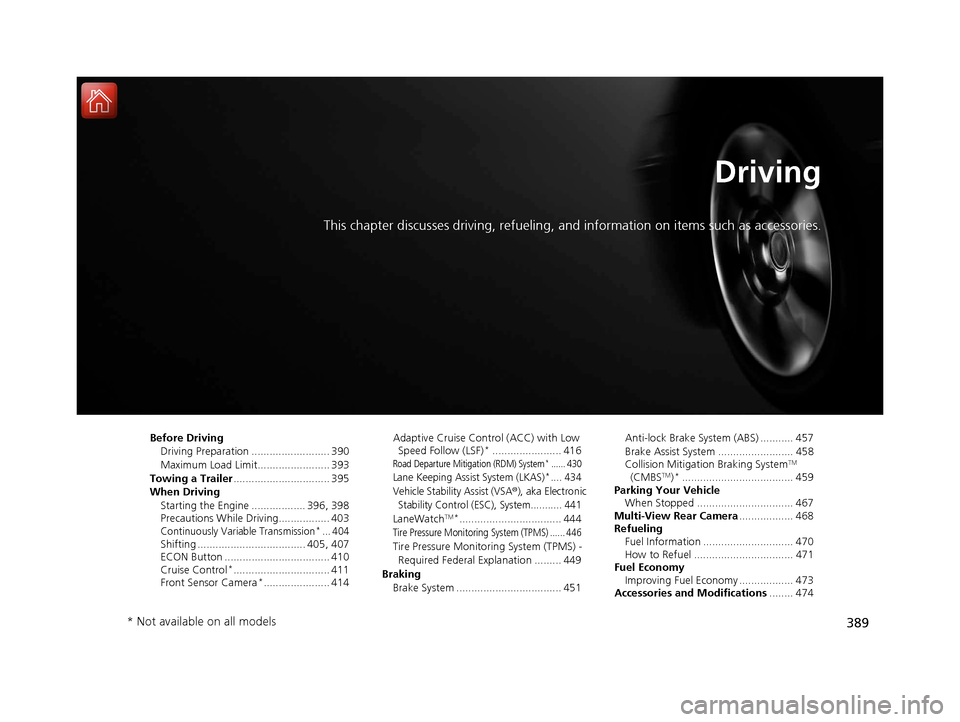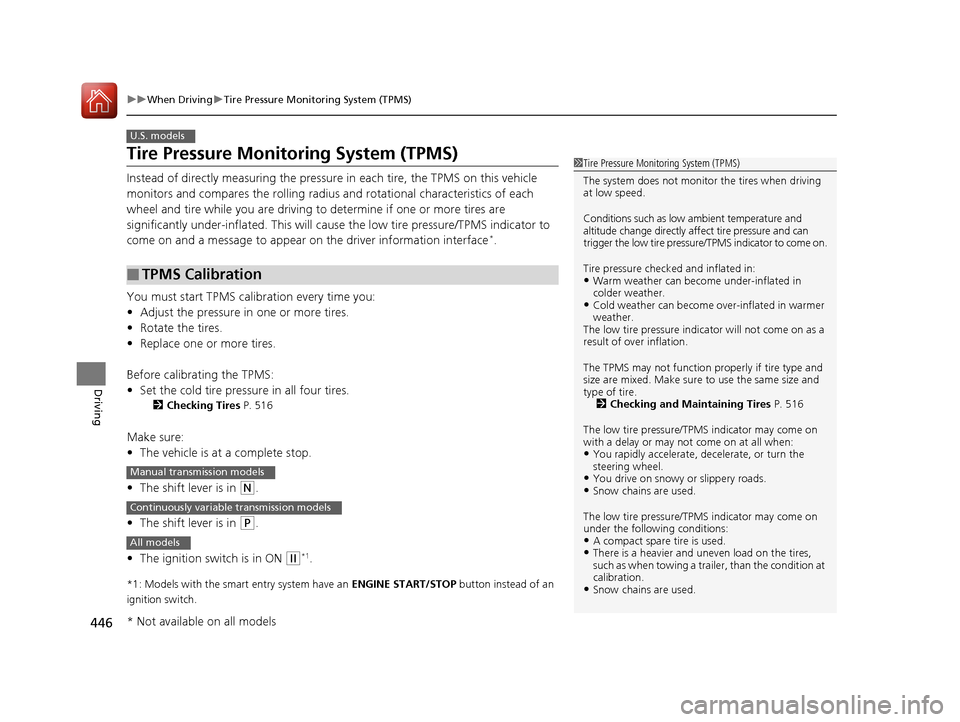2016 HONDA CIVIC towing
[x] Cancel search: towingPage 3 of 590

Contents
This owner’s manual should be considered a permanent part of the
vehicle and should remain with the vehicle when it is sold.
This owner’s manual covers all models of your vehicle. You may find
descriptions of equipment and features that are not on your
particular model.
Images throughout this owner’s manual (including the front cover)
represent features and equipment that are available on some, but
not all, models. Your particular mo del may not have some of these
features.
This owner’s manual is for vehicles sold in the United States and
Canada.
The information and specifications in cluded in this publication were
in effect at the time of approval for printing. Honda Motor Co., Ltd.
reserves the right, however, to discontinue or change specifications
or design at any time without notice and without incurring any
obligation.2 Safe Driving P. 31
For Safe Driving P. 32 Seat Belts P. 36 Airbags P. 44
2Instrument Panel P. 73
Indicators P. 74 Gauges and Displays P. 103
2Controls P. 121
Clock P. 122 Locking and Unlocking the Doors P. 124
Opening and Closing the Moonroof* P. 150
Adjusting the Seats P. 167
Climate Control System
* P. 190
2 Features P. 197
Audio System P. 198 Audio System Basic Operation P. 205, 223
Customized Features P. 302 Bluetooth® HandsFreeLink ®* P. 333, 356
2Driving P. 389
Before Driving P. 390 Towing a Trailer P. 395
Multi-View Rear Camera P. 468 Refueling P. 470
2Maintenance P. 475
Before Performing Maintenance P. 476 Maintenance MinderTM P. 479
Checking and Maintaining Wiper Blades P. 514
Heating System
*/Climate Control System* Maintenance P. 529
2 Handling the Unexpected P. 535
Tools P. 536 If a Tire Goes Flat P. 537
Overheating P. 550 Indicator, Coming On/Blinking P. 552
When You Cannot Open the Trunk P. 564 Refueling P. 565
2Information P. 567
Specifications P. 568 Identification Numbers P. 572
Emissions Testing P. 575 Warranty Coverages P. 577
16 CIVIC 4D-31TBA6000.book 2 ページ 2015年8月31日 月曜日 午後5時56分
Page 4 of 590

Contents
Child Safety P. 58Exhaust Gas Hazard P. 70Safety Labels P. 71
Opening and Closing the Trunk P. 141 Security System P. 144 Opening and Closing the Windows P. 147
Operating the Switches Around the Steering Wheel P. 151 Adjusting the Mirrors P. 165
Interior Lights/Interior Convenience Items P. 175 Heating System
* P. 187
Audio Error Messages P. 293General Information on the Audio System P. 296
When Driving P. 396 Braking P. 451Parking Your Vehicle P. 467
Fuel Economy P. 473 Accessories and Modifications P. 474
Maintenance Under the Hood P. 489 Replacing Light Bulbs P. 504
Checking and Maintaining Tires P. 516 Battery P. 525 Remote Transmitter Care P. 527
Cleaning P. 530
Engine Does Not Start P. 543 Jump Starting P. 546 Shift Lever Does Not Move P. 549
Fuses P. 558 Emergency Towing P. 562 When You Cannot Unlock the Fuel Fill Door P. 563
Devices that Emit Radio Waves P. 573 Reporting Safety Defects P. 574
Authorized Manuals P. 579 Customer Service Information P. 580
Quick Reference GuideP. 4
Safe DrivingP. 31
Instrument PanelP. 73
ControlsP. 121
FeaturesP. 197
DrivingP. 389
MaintenanceP. 475
Handling the UnexpectedP. 535
InformationP. 567
IndexP. 581
16 CIVIC 4D-31TBA6000.book 3 ページ 2015年8月31日 月曜日 午後5時56分
Page 28 of 590

Quick Reference Guide
27
Handling the Unexpected (P 535)
Flat Tire (P 537)
● Park in a safe location and replace the
flat tire with the comp act spare tire in the
trunk.
Indicators Come On
(P 552)
● Identify the indica tor and consult the
owner's manual.
Engine Won’t Start
(P 543)
● If the battery is dead, jump start using a
booster battery.
Blown Fuse (P 558)
● Check for a blown fuse if an electrical
device does not operate.
Overheating (P 550)
● Park in a safe location. If you do not see
steam under the hood, open the hood,
and let the engine cool down.
Emergency Towing
(P 562)
●Call a professional towing service if you
need to tow your vehicle.
16 CIVIC 4D-31TBA6000.book 27 ページ 2015年8月31日 月曜日 午後5時56分
Page 390 of 590

389
Driving
This chapter discusses driving, refueling, and information on items such as accessories.
Before Driving
Driving Preparation .......................... 390
Maximum Load Limit........................ 393
Towing a Trailer ................................ 395
When Driving
Starting the Engine .................. 396, 398
Precautions While Driving................. 403
Continuously Variable Transmission*... 404Shifting .................................... 405, 407
ECON Button ................................... 410
Cruise Control
*................................ 411
Front Sensor Camera*...................... 414 Adaptive Cruise Control (ACC) with Low
Speed Follow (LSF)
*....................... 416Road Departure Mitigation (RDM) System*...... 430
Lane Keeping Assist System (LKAS)*.... 434
Vehicle Stabilit y Assist (VSA
®), aka Electronic
Stability Control (ESC), System........... 441
LaneWatchTM*.................................. 444
Tire Pressure Monitoring System (TPMS) ...... 446
Tire Pressure Monitoring System (TPMS) - Required Federal Explanation ......... 449
Braking Brake System ................................... 451 Anti-lock Brake System (ABS) ........... 457
Brake Assist System ......................... 458
Collision Mitigation Braking System
TM
(CMBSTM)*..................................... 459
Parking Your Vehicle When Stopped ................................ 467
Multi-View Rear Camera .................. 468
Refueling Fuel Information .............................. 470
How to Refuel ................................. 471
Fuel Economy Improving Fuel Economy .................. 473
Accessories and Modifications ........ 474
* Not available on all models
16 CIVIC 4D-31TBA6000.book 389 ページ 2015年8月31日 月曜日 午後5時56分
Page 394 of 590

393
uuBefore Driving uMaximum Load Limit
Continued
Driving
Maximum Load Limit
The maximum load for your vehicl e is 850 lbs (385 kg). See the
Tire and Loading Information la bel attached to the driver’s
doorjamb.
This figure includes the total weig ht of all occupants, cargo, and
accessories, and the tongue load if you are towing a trailer.
Steps for Determining Correct Load Limit -
(1) Locate the statement “The comb ined weight of occupants and
cargo should never exceed XXX kg or XXX lbs.” on your
vehicle’s placard.
(2) Determine the combined weight of the driver and passengers
that will be riding in your vehicle.
(3) Subtract the combined weight of the driver and passengers
from XXX kg or XXX lbs.
(4) The resulting figure equals the available amount of cargo and
luggage load capacity. For example, if the “XXX” amount
equals 1,400 lbs. and there will be five 150 lb. passengers in
your vehicle, the am ount of available cargo and luggage load
capacity is 650 lbs. (1,400 - 750 (5 x 150) = 650 lbs.)1 Maximum Load Limit
Gross Vehicle Weight Rating (GVWR):
The maximum allowable weight of the vehicle, all
occupants, all accessories, all cargo, and the tongue
load. 2 Specifications P. 568, 570
Gross Axle Weight Rating (GAWR):
The maximum allowable weight of the vehicle axle. 2 Specifications P. 568, 570
3WARNING
Overloading or improper loading
can affect handling and stability
and cause a crash in which you
can be hurt or killed.
Follow all load limits and other
loading guidelines in this manual.
Label Example
16 CIVIC 4D-31TBA6000.book 393 ページ 2015年8月31日 月曜日 午後5時56分
Page 395 of 590

394
uuBefore Driving uMaximum Load Limit
Driving
(5) Determine the combined weight of luggage and cargo being
loaded on the vehicle. That we ight may not safely exceed the
available cargo and luggage load capacity calculated in step 4.
(6) If your vehicle will be towing a tra iler, load from your trailer will
be transferred to your vehicl e. Consult this manual to
determine how this reduces the available cargo and luggage
load capacity of your vehicle.
In addition, the total weight of the vehicle, all occupants,
accessories, cargo, and trailer tongue load must not exceed the
Gross Vehicle Weight Rating (GVW R) or the Gross Axle Weight
Rating (GAWR). Both are on a label on the driver’s doorjamb.
Load Limits Example
Example1
Max Load 850 lbs
(385 kg) Passenger Weight
150 lbs x 2 = 300 lbs (68 kg x 2 = 136 kg) Cargo Weight
550 lbs
(249 kg)
Example2 Max Load 850 lbs
(385 kg) Passenger Weight
150 lbs x 5 = 750 lbs (68 kg x 5 = 340 kg) Cargo Weight
100 lbs
(45 kg)
16 CIVIC 4D-31TBA6000.book 394 ページ 2015年8月31日 月曜日 午後5時56分
Page 396 of 590

395
Driving
Towing a Trailer
Your vehicle is not designed to tow a trailer. Attempting to do so can void your
warranties.
16 CIVIC 4D-31TBA6000.book 395 ページ 2015年8月31日 月曜日 午後5時56分
Page 447 of 590

446
uuWhen Driving uTire Pressure Monitoring System (TPMS)
Driving
Tire Pressure Monitoring System (TPMS)
Instead of directly measuring the pressu re in each tire, the TPMS on this vehicle
monitors and compares the rolling radius and rotational characteristics of each
wheel and tire while you are driving to determine if one or more tires are
significantly under-inflated. This will caus e the low tire pressure/TPMS indicator to
come on and a message to appear on the driver information interface
*.
You must start TPMS calibration every time you:
• Adjust the pressure in one or more tires.
• Rotate the tires.
• Replace one or more tires.
Before calibrating the TPMS:
• Set the cold tire pressu re in all four tires.
2Checking Tires P. 516
Make sure:
•The vehicle is at a complete stop.
• The shift lever is in
(N.
• The shift lever is in
(P.
• The ignition switch is in ON
(w*1.
*1: Models with the smart entry system have an ENGINE START/STOP button instead of an
ignition switch.
■TPMS Calibration
U.S. models
1 Tire Pressure Monitoring System (TPMS)
The system does not monitor the tires when driving
at low speed.
Conditions such as low ambient temperature and
altitude change directly a ffect tire pressure and can
trigger the low tire pressure/TPMS indicator to come on.
Tire pressure checked and inflated in:
•Warm weather can beco me under-inflated in
colder weather.
•Cold weather can become over-inflated in warmer
weather.
The low tire pressure indica tor will not come on as a
result of over inflation.
The TPMS may not function pr operly if tire type and
size are mixed. Make sure to use the same size and
type of tire. 2 Checking and Maintaining Tires P. 516
The low tire pressure/TPMS indicator may come on
with a delay or may not come on at all when:
•You rapidly accelerate, decelerate, or turn the
steering wheel.
•You drive on snowy or slippery roads.•Snow chains are used.
The low tire pressure/TPMS indicator may come on
under the following conditions:
•A compact spare tire is used.•There is a heavier and une ven load on the tires,
such as when towing a trailer, than the condition at
calibration.
•Snow chains are used.
Manual transmission models
Continuously variable transmission models
All models
* Not available on all models
16 CIVIC 4D-31TBA6000.book 446 ページ 2015年8月31日 月曜日 午後5時56分